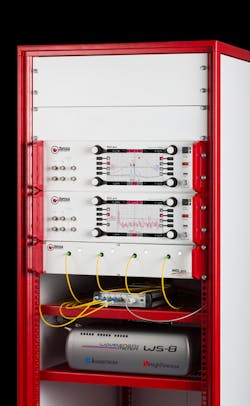German quantum initiative QUTEGA starts with optical single ion clock
The German Federal Ministry of Education and Research (BMBF) has initiated a strategic process within the field of quantum technologies that stresses the importance of this field for the economy and science in Germany. To implement the first steps, the BMBF has selected three pilot projects addressing important developments in quantum technologies. The first pilot project, optIclock--optical single ion clock, began in May 2017.
The project is known as QUTEGA (Quantentechnologie - Grundlagen und Anwendungen or Quantum technology - Fundamentals and Applications) and is led by Toptica Photonics (Munich, Germany) and the National Metrology Institute of Germany (PTB; Braunschweig) with the goal of realizing a demonstrator device for an optical single ion clock within three years. The research consortium consists of Ferdinand Braun Institute Berlin, High Finesse, Menlo Systems, PTB, QUARTIQ, Qubig, Toptica Photonics, University of Bonn, University of Siegen, and Vacom. The project will receive 4.5 million euros of BMBF funding and 1.5 million euros from participating industrial partners, for a total of 6 million euro.
The optIclock project is intended to render the enormous potential of quantum technologies into something useful beyond academic research. So far, the best optical clocks require the continual intervention of highly trained scientific personnel and are operated for a limited time of typically a few days in dedicated measurement campaigns. The optIclock demonstrator aims at a slightly reduced accuracy--by a factor of 10 to 100--which is still better than any commercial clock or frequency standard. In contrast to the laboratory solutions, the optIclock will be transportable and nonscientific users will be able to operate it even in an office environment.
Applications of such devices include the direct measurement of time via the realization of a highly accurate frequency standard, the precise synchronization of large networks or distributed radio telescopes, and navigation in general as well as the improvement of global satellite navigation systems. In particular, the clocks could be deployed as specialized quantum sensors that measure gravitational height differences over large distances by frequency comparisons. This promises a variety of applications in geodesy, such as measuring changes of the sea level and the uplifting/sinking of landmass.
The optIclock device contains a single charged atom that is kept in an electrical trap within an ultra-high vacuum compartment. The atom is laser-cooled to a few Millikelvin (1 Millikelvin = -273.149 °C = -459,668 °F) and a so-called clock laser is stabilized to an optical transition within this atom. To make the device useful for general operators, this pilot project will investigate miniaturization, automation, and the integration of individual components and design of a comprehensive architecture for the complete system. Many other quantum technology applications such as quantum computing, quantum simulation, or quantum sensing will benefit from the optIclock developments of key technologies and concepts.
Source: Toptica Photonics
About the Author

Conard Holton
Conard Holton has 25 years of science and technology editing and writing experience. He was formerly a staff member and consultant for government agencies such as the New York State Energy Research and Development Authority and the International Atomic Energy Agency, and engineering companies such as Bechtel. He joined Laser Focus World in 1997 as senior editor, becoming editor in chief of WDM Solutions, which he founded in 1999. In 2003 he joined Vision Systems Design as editor in chief, while continuing as contributing editor at Laser Focus World. Conard became editor in chief of Laser Focus World in August 2011, a role in which he served through August 2018. He then served as Editor at Large for Laser Focus World and Co-Chair of the Lasers & Photonics Marketplace Seminar from August 2018 through January 2022. He received his B.A. from the University of Pennsylvania, with additional studies at the Colorado School of Mines and Medill School of Journalism at Northwestern University.
